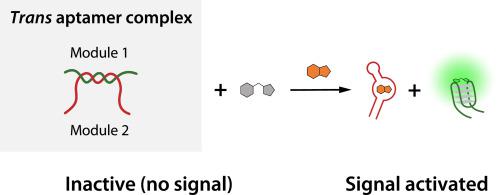当前位置:
X-MOL 学术
›
Anal. Chim. Acta
›
论文详情
Our official English website, www.x-mol.net, welcomes your feedback! (Note: you will need to create a separate account there.)
In vitro selection of a trans aptamer complex for target-responsive fluorescence activation
Analytica Chimica Acta ( IF 6.2 ) Pub Date : 2024-03-11 , DOI: 10.1016/j.aca.2024.342465 Soyeon V. Park , Byunghwa Kang , Minjong Lee , Hyebin Yoo , Hyesung Jo , Sungwook Woo , Seung Soo Oh
Analytica Chimica Acta ( IF 6.2 ) Pub Date : 2024-03-11 , DOI: 10.1016/j.aca.2024.342465 Soyeon V. Park , Byunghwa Kang , Minjong Lee , Hyebin Yoo , Hyesung Jo , Sungwook Woo , Seung Soo Oh

|
Most biological molecular complexes consist of multiple functional domains, yet rationally constructing such multifunctional complexes is challenging. Aptamers, the nucleic acid-based functional molecules, can perform multiple tasks including target recognition, conformational changes, and enzymatic activities, while being chemically synthesizable and tunable, and thus provide a basis for engineering enhanced functionalities through combination of multiple units. However, the conventional approach of simply combining aptamer units in a serial manner is susceptible to undesired crosstalk or interference between the aptamer units and to false interactions with non-target molecules; besides, the approach would require additional mechanisms to separate the units if they are desired to function independently. It is clearly a challenge to develop multi-aptamer complexes that preserve independent functions of each unit while avoiding undesired interference and non-specific interactions. By directly in vitro selecting a ‘trans’ aptamer complex, we demonstrate that one aptamer unit (‘utility module’) can remain hidden or ‘inactive’ until a target analyte triggers the other unit (‘sensing module’) and separates the two aptamers. Since the operation of the utility module occurs free from the sensing module, unnecessary crosstalk between the two units can be avoided. Because the utility module is kept inactive until separated from the complex, non-specific interactions of the hidden module with noncognate targets can be naturally prevented. In our demonstration, the sensing module was selected to detect serotonin, a clinically important neurotransmitter, and the target-binding-induced structure-switching of the sensing module reveals and activates the utility module that turns on a fluorescence signal. The aptamer complex exhibited a moderately high affinity and an excellent specificity for serotonin with ∼16-fold discrimination against common neurotransmitter molecules, and displayed strong robustness to perturbations in the design, disallowing nonspecific reactions against various challenges. This work represents the first example of a trans aptamer complex that was in vitro selected de novo. The trans aptamer complex selected by our strategy does not require chemical modifications or immediate optimization processes to function, because the complex is directly selected to perform desired functions. This strategy should be applicable to a wide range of functional nucleic acid moieties, which will open up diverse applications in biosensing and molecular therapeutics.
中文翻译:

用于靶标响应荧光激活的反式适体复合物的体外选择
大多数生物分子复合物由多个功能域组成,但合理构建此类多功能复合物具有挑战性。适体是一种基于核酸的功能分子,可以执行包括靶标识别、构象变化和酶活性在内的多种任务,同时是可化学合成和可调的,从而为通过多个单元的组合工程增强功能提供了基础。然而,以串行方式简单组合适体单元的传统方法容易受到适体单元之间不期望的串扰或干扰以及与非靶分子的错误相互作用的影响;此外,如果希望这些单元独立运作,该方法将需要额外的机制来分隔这些单元。开发多适体复合物来保留每个单元的独立功能,同时避免不需要的干扰和非特异性相互作用,显然是一个挑战。通过直接在体外选择“反式”适体复合物,我们证明一个适体单元(“实用模块”)可以保持隐藏或“不活动”,直到目标分析物触发另一个单元(“传感模块”)并分离两个适体。由于实用模块的操作不受感测模块影响,因此可以避免两个单元之间不必要的串扰。由于实用程序模块在与复杂的分离之前保持不活动状态,因此可以自然地防止隐藏模块与非同源目标的非特定交互。在我们的演示中,选择传感模块来检测血清素(一种临床上重要的神经递质),并且传感模块的目标结合诱导的结构转换揭示并激活打开荧光信号的实用模块。该适体复合物对血清素表现出中等高的亲和力和优异的特异性,对常见神经递质分子具有约16倍的辨别力,并且对设计中的扰动表现出很强的鲁棒性,不允许针对各种挑战的非特异性反应。这项工作代表了体外从头选择反式适体复合物的第一个例子。我们的策略选择的反式适体复合物不需要化学修饰或立即优化过程即可发挥作用,因为直接选择复合物来执行所需的功能。这种策略应该适用于广泛的功能性核酸部分,这将在生物传感和分子治疗领域开辟多种应用。
更新日期:2024-03-11
中文翻译:

用于靶标响应荧光激活的反式适体复合物的体外选择
大多数生物分子复合物由多个功能域组成,但合理构建此类多功能复合物具有挑战性。适体是一种基于核酸的功能分子,可以执行包括靶标识别、构象变化和酶活性在内的多种任务,同时是可化学合成和可调的,从而为通过多个单元的组合工程增强功能提供了基础。然而,以串行方式简单组合适体单元的传统方法容易受到适体单元之间不期望的串扰或干扰以及与非靶分子的错误相互作用的影响;此外,如果希望这些单元独立运作,该方法将需要额外的机制来分隔这些单元。开发多适体复合物来保留每个单元的独立功能,同时避免不需要的干扰和非特异性相互作用,显然是一个挑战。通过直接在体外选择“反式”适体复合物,我们证明一个适体单元(“实用模块”)可以保持隐藏或“不活动”,直到目标分析物触发另一个单元(“传感模块”)并分离两个适体。由于实用模块的操作不受感测模块影响,因此可以避免两个单元之间不必要的串扰。由于实用程序模块在与复杂的分离之前保持不活动状态,因此可以自然地防止隐藏模块与非同源目标的非特定交互。在我们的演示中,选择传感模块来检测血清素(一种临床上重要的神经递质),并且传感模块的目标结合诱导的结构转换揭示并激活打开荧光信号的实用模块。该适体复合物对血清素表现出中等高的亲和力和优异的特异性,对常见神经递质分子具有约16倍的辨别力,并且对设计中的扰动表现出很强的鲁棒性,不允许针对各种挑战的非特异性反应。这项工作代表了体外从头选择反式适体复合物的第一个例子。我们的策略选择的反式适体复合物不需要化学修饰或立即优化过程即可发挥作用,因为直接选择复合物来执行所需的功能。这种策略应该适用于广泛的功能性核酸部分,这将在生物传感和分子治疗领域开辟多种应用。



























 京公网安备 11010802027423号
京公网安备 11010802027423号